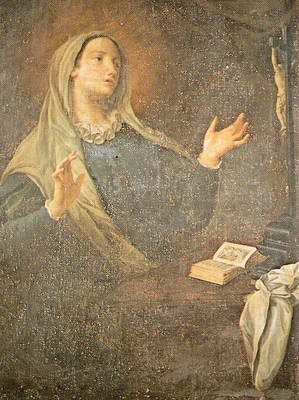



A Saint Mystic on Purgatory
Matthew Harrison
Thursday, January 13, 2011
Pope Benedict XVI's Wednesday general audience this week highlights the life of St. Catherine of Genoa.
 Two things stood out for me about this talk: the 15th century saint's words on purgatory and also what the Holy Father said about mystics. He recounted the "profound union" Catherine had with God, but that she also cared the sick and the poor at hospital of Pammatone. "These two poles -- God and neighbor -- filled her life," said the Holy Father. We often think of mystics as living away from people and not living a practical life, but one of contemplation. But Pope Benedict noted:
Two things stood out for me about this talk: the 15th century saint's words on purgatory and also what the Holy Father said about mystics. He recounted the "profound union" Catherine had with God, but that she also cared the sick and the poor at hospital of Pammatone. "These two poles -- God and neighbor -- filled her life," said the Holy Father. We often think of mystics as living away from people and not living a practical life, but one of contemplation. But Pope Benedict noted:
 Two things stood out for me about this talk: the 15th century saint's words on purgatory and also what the Holy Father said about mystics. He recounted the "profound union" Catherine had with God, but that she also cared the sick and the poor at hospital of Pammatone. "These two poles -- God and neighbor -- filled her life," said the Holy Father. We often think of mystics as living away from people and not living a practical life, but one of contemplation. But Pope Benedict noted:
Two things stood out for me about this talk: the 15th century saint's words on purgatory and also what the Holy Father said about mystics. He recounted the "profound union" Catherine had with God, but that she also cared the sick and the poor at hospital of Pammatone. "These two poles -- God and neighbor -- filled her life," said the Holy Father. We often think of mystics as living away from people and not living a practical life, but one of contemplation. But Pope Benedict noted:
We must not forget that the more we love God and are constant in prayer, the more we will truly love those who are around us, those who are close to us, because we will be able to see in every person the face of the Lord, who loves without limits or distinctions. Mysticism does not create distances with others; it does not create an abstract life, but brings one closer to others because one begins to see and act with the eyes, with the heart of God.It's a point worth thinking about, not only in the context of the saint mystics, but in our own lives. How does our prayer life translate into action? How does the love that we express to God, and that is shown to us by God, translate into the love of our neighbour? Regular viewers of Lectio Divina with Archbishop Thomas Collins will know one of his common phrases in meditating on Scripture is that we should ask ourselves: what does this say to my head, my heart, and my hands? That I may know the Lord better. Love the Lord better. And serve the Lord better. And one of the ways to serve the Lord, is in the love of our neighbour. Pope Benedict also spoke about St. Catherine's Treatise on Purgatory and Dialogues on the Soul and Body. In addition to reminding the faithful of the importance of praying "for the deceased so that they can attain the blessed vision of God," the Holy Father also shared how Catherine spoke of the interior fire and purification of purgatory:
The soul is conscious of the immense love and perfect justice of God and, in consequence, suffers for not having responded correctly and perfectly to that love, and that is why the love itself of God becomes a flame. Love itself purifies it from its dross of sin.I recommend reading the full text, from Zenit, which is found below. And, as is the case every week, you can tune into Salt + Light for the general audience every Thursday at 3:30pm/10:00 pm ET or 12:30 pm/7:00pm PT.
On St. Catherine of Genoa Dear Brothers and Sisters! Today I would like to speak about another saint who, like Catherine of Siena and Catherine of Bologna, is also called Catherine; I am speaking of Catherine of Genoa, who is best known for her visions of purgatory. The text that tells us about her life and thought was published in the Ligurian city in 1551; it is divided in three parts: "Vita," (Life) on her life itself; "Dimostratione et dechiaratione del purgatorio" (Demonstration and Declaration of Purgatory) -- better known as "Trattato" (Treatise on Purgatory); and "Dialogo tra l’anima e il corpo" (Dialogues on the Soul and Body).[1] The compiler of Catherine's work was her confessor, the priest Cattaneo Marabotto. Continue reading- Image: St. Catherine of Genoa, by 18th century painter Giovanni Agostino Ratti.
Related Articles:
<<
SUPPORT LABEL
$50
$100
$150
$250
OTHER AMOUNT
DONATE
Receive our newsletters
Stay Connected
Receive our newsletters

Stay Connected







